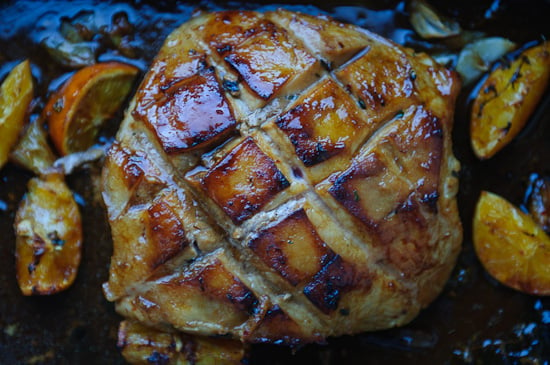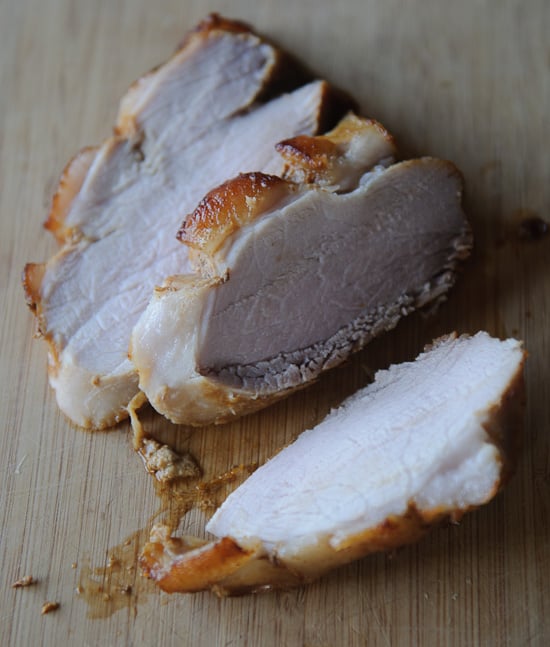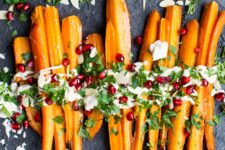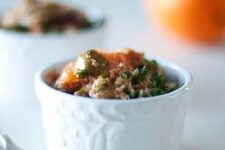“When daily life is directly tied to the ebbs and flows of nature, as they are in agriculture, one cannot help but observe that life and death are forever in service to one another. We nurture the newborn livestock, and we process the ones that are ready for market. We harvest one crop, we plant seeds for another.”
– Shannon Hayes (from Long Way on a Little: An Earth Lover’s Companion for Enjoying Meat, Pinching Pennies and Living Deliciously)
Meat consumption can be a confusing- and polarizing- topic in the health community: many people seem to avoid meat because they believe it to be “bad” for them/”bad” for the environment/”bad” for animal welfare. I personally do not believe meat is “bad” (nor do I believe it needs to be avoided if you enjoy it) and I talk extensively about why in my book. To sum up, meat has a very rich nutritional profile (animal foods are a wonderful source of protein, but also contain additional nutrients that simply cannot be found elsewhere), especially when it comes from animals raised on ample pasture. In addition, I believe traditional animal husbandry is a humane and sustainable practice; I want to support farmers outside of the industrial factory farming system…farmers who truly care for/don’t confine their animals and who allow them to graze as nature intended.
I feel very fortunate that here in NY’s Hudson Valley where I live, I am surrounded by a number of farms where the animals and land are managed in a holistic way. These farms don’t confine the animals, nor feed them a grain-based diet, nor give them antibiotics or hormones. They allow the animals to roam freely in the sunshine and fresh air, grazing on nutrient-dense pasture.
One such farm is Full Moon Farm, and when the folks from the farm asked me if I’d be willing to develop some recipes with their products, I was really excited. Though I don’t post recipes for meat here on the blog all that often, meat is definitely a part of my diet, a diet that I consider to be quite health-promoting and balanced. So of course I said “yes”. This means that in the future, you can expect to see a few more meaty recipes!
Today, I want to share one of them with you: a roasted fresh ham that’s a really nice option for family dinner such as Easter.
About pastured pork/ham:
Unlike cows, pigs are omnivores. Pigs raised on pasture farms do graze, but they eat many other things, too (their diet is often supplemented with grain). Pastured pork is generally much more flavorful-and healthier-than commercial pork because they pigs have access to the outdoors and eat a much more diverse diet.
“Ham” refers to the hind leg of the pork. A roasted pastured fresh ham is very different from the cured/salty/overly sweet hams many of us are accustomed to, but it’s quite delicious in its own right. Keep in mind that a fresh uncured ham will have been frozen by the farmer, a step that is necessary to prevent food-borne pathogens in pork. A well-sealed/air-tight package of fresh ham should keep for 6 months before cooking.
A fresh ham may come in various sizes and may be cured, smoked, or roasted. This recipe calls for a boneless fresh ham that is approximately 4 pounds.
[cft format=0]
More fresh ham recipes:
Grilled Molasses and Rum Glazed Fresh Ham from Epicurious
Fresh Ham with Rosemary, Garlic, and Lemon from Fine Cooking
New Year’s Day Fresh Ham from Food52
Further reading on the ethics/sustainability/cooking of pastured meats:
Pasture Perfect: How You Can Benefit from Choosing Meat, Eggs, and Dairy Products from Grass-Fed Animals
Salad Bar Beef
The Nourished Kitchen: Farm-to-Table Recipes for the Traditional Foods Lifestyle Featuring Bone Broths, Fermented Vegetables, Grass-Fed Meats, Wholesome Fats, Raw Dairy, and Kombuchas
Meat: A Benign Extravagance
Odd Bits: How to Cook the Rest of the Animal
The Butcher’s Guide to Well-Raised Meat: How to Buy, Cut, and Cook Great Beef, Lamb, Pork, Poultry, and More
Disclosure: Links to Amazon.com are affiliate links. When you make a purchase via one of my links, I make a small commission. This helps me support my blogging activities…thank you.
Roasted Fresh Ham with Bourbon, Citrus, and Maple Glaze
Ingredients
- *one pastured boneless fresh ham about 4 pounds
- *2 tablespoons salt I like to use coarse sea salt
- *1 navel orange remove the zest with a microplane (rasp grater and set aside, then slice the orange into 8 sections)
- *2 teaspoons fresh thyme leaves plus additional sprigs of fresh thyme for the roasting pan
- *generous pinch of crushed red pepper flakes
- *¼ cup orange juice preferably freshly squeezed
- *1/4 cup bourbon
- *1/4 cup maple syrup
- *1-2 large shallots or 1 onion peeled and roughly chopped
Instructions
- 1. 12-24 hours before you are going to roast the ham, combine the salt with the orange zest, thyme leaves, and crushed red pepper flakes. Rub all over the ham, then place in a plastic bag and refrigerate.
- 2. When you are ready to roast the ham, remove it from the refrigerator and pre-heat the oven to 500 degrees F. In a small bowl, combine the orange juice, bourbon, and maple syrup.
- 3. Using a sharp knife, score entire surface of ham in a crosshatch pattern, cutting down just through skin to the flesh underneath. Place ham in a roasting pan skin side up and pour the juice mixture over the ham. Scatter the orange slices and the shallot or onion pieces around the ham and place the roasting pan in the oven. Cook for 20 minutes.
- 4. Remove the ham from the oven and baste with the pan juices. Reduce oven setting to 350 degrees F. Continue to baste the ham every 15 minutes or so and cook for another 45 minutes-55 minutes, until the very center of the ham reaches an internal temperature of 145-160 degrees, depending on your personal taste. (If you find the bottom of the pan looking very dry, you can add a little water or chicken/beef stock to moisten it, if you like.)
- 5. When ham is done, remove it from roasting pan, cover it loosely with foil, and allow it to rest for 20 to 30 minutes. Keep in mind that it will continue to cook a bit while resting so be sure not to overcook in the oven.
- 6. Carve ham into thick slices and serve with the pan juices spooned over.








